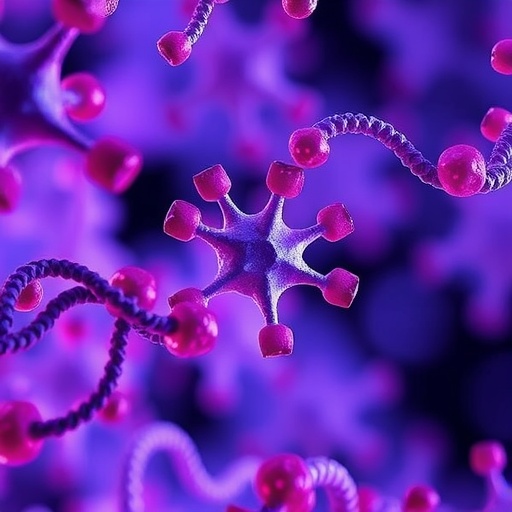The intricate dance between cell cycle regulators and the tumor immune microenvironment (TIME) is emerging as a crucial frontier in cancer research. Abnormal cell proliferation stands as a cardinal characteristic of malignant tumors, orchestrated predominantly by a suite of proteins that meticulously control the phases of the cell cycle. Recent advances have illuminated the dualistic role these cell cycle proteins play—not only driving unchecked tumor growth but also shaping the immune landscape within and around tumors. A groundbreaking review from the First Affiliated Hospital of Anhui Medical University, featured in the journal Genes & Diseases, consolidates cutting-edge findings on how cyclin-dependent kinases (CDKs) and their regulators influence anti-tumor immunity and offers compelling insight into new therapeutic avenues.
Cell cycle proteins are traditionally categorized into positive and negative regulators, each with distinct functions. Positive regulators such as cyclins and CDKs catalyze progression through key cell cycle checkpoints, thereby promoting cell division. In contrast, negative regulators like p21 and p16 function as molecular brakes, restraining uncontrolled cycle progression to maintain cellular homeostasis. However, this paradigm expands considerably when viewed through the lens of cancer, where deregulated cell cycle proteins simultaneously modulate the tumor microenvironment (TME), a complex ecosystem comprising immune cells, stromal cells, signaling molecules, and extracellular matrix components.
Within the positive regulatory cadre, CDK1, CDK2, CDK5, CDK6, CDK7, CDK9, and CDK20 exhibit aberrant expression profiles across different tumor types, directly influencing the composition and functionality of immune cells within the TME. For instance, in lung adenocarcinoma, CDK1 is notably overexpressed in tumor compartments and works in tandem with the chemokine CXCL8 expressed by macrophages. This interaction fosters an immunosuppressive niche, enabling tumors to evade immune surveillance and flourish. Intriguingly, pharmacological inhibition of CDK1 disrupts this axis, downregulating CXCL8 transcription and reprogramming macrophages away from their tumor-promoting states, culminating in suppressed tumor growth.
Triple-negative breast cancer (TNBC), a notoriously aggressive basal-like subtype, holds another example where cell cycle regulation intertwines with immune evasion. Elevated levels of the cyclin E/CDK2 complex typify these tumors. The CDK2 inhibitor SNS-032 has demonstrated potent anti-cancer efficacy by inducing extensive tumor cell death, thereby releasing a cache of cellular debris that acts as a beacon recruiting cytotoxic T lymphocytes (CTLs). This recruitment invigorates the immune response against tumor cells. Additionally, SNS-032 lifts the expression of PD-L1 in residual tumor cells, paradoxically illuminating susceptibility to immune checkpoint blockade. When combined with the anti-PD-L1 antibody avelumab, SNS-032 potentiates natural killer (NK) cell cytotoxicity via antibody-dependent mechanisms, effectively orchestrating a multipronged immune assault.
The interplay between cell cycle proteins and immune checkpoint pathways further manifests in medulloblastoma. Here, interferon-γ (IFN-γ) provokes PD-L1 expression through a complex regulatory nexus involving CDK5. IFN-γ not only triggers PD-L1 transcription via IRF-1 but simultaneously upregulates p35, an activator of CDK5. This activation diminishes the repressive influence of the IRF2/IRF2BP2 complex on PD-L1 gene expression, allowing tumor cells to escape immune destruction. Genetic ablation of CDK5 in experimental models results in decreased PD-L1, increased infiltration of cytotoxic CD8+ T cells, and a reduction in regulatory T cells (Tregs), collectively tipping the balance toward immune-mediated tumor elimination.
Expanding the scope, the review accentuates that through cell cycle-associated signaling, diverse immune subsets—ranging from dendritic cells (DCs) and macrophages to myeloid-derived suppressor cells (MDSCs) and T cell subsets—are dynamically modulated. For example, negative regulators like p21 function beyond cell cycle arrest, acting as enhancers of immunosurveillance by promoting the senescence-associated secretory phenotype (SASP), which can either support or hinder anti-tumor responses depending on context. Similarly, the lincRNA-p21 in tumor-associated macrophages (TAMs) serves as a pivotal switch, where its knockdown encourages M1 macrophage polarization, a phenotype conducive to tumor suppression.
The therapeutic implications of targeting these molecular regulators have gained substantial momentum. A suite of CDK inhibitors, each with unique specificity profiles, has traversed from bench to bedside. Trials with pan-CDK2 inhibitors such as SNS-032, CDK4/6 inhibitors including abemaciclib and palbociclib, as well as CDK7 inhibitors like YKL-5-124, demonstrate that impairing cell cycle machinery can recondition the immunological milieu. Such interventions may transform immunologically “cold” tumors—those refractory to immune activation—into “hot” tumors endowed with robust immune infiltrates.
Crucially, combination strategies augment these effects, integrating CDK inhibition with immune checkpoint blockade or other targeted therapies. The synergy is evident in preclinical models where concurrent modulation leads to enhanced tumor regression and prolonged survival. Moreover, personalized therapeutic regimens mindful of the tumor’s unique CDK profile promise precision medicine approaches that optimize efficacy while curbing adverse effects.
This review also underlines the necessity of dissecting cell cycle protein function within different cellular compartments of the TME, given that the same protein may elicit divergent effects depending on contextual cues. Such nuanced understanding is indispensable for refining therapeutic targets and anticipating resistance mechanisms that tumors inevitably deploy.
By bridging cancer cell proliferation with immune regulation, cell cycle proteins emerge not solely as drivers of tumor growth but as lynchpins of immune escape and therapeutic resistance. Their dualistic nature invites innovation in drug design and immunotherapy, fostering a new era in oncology where the cell cycle is both a target and a biomarker.
In summary, the comprehensive synthesis provided by researchers at Anhui Medical University elucidates the multifaceted roles of cell cycle proteins in sculpting the tumor immune microenvironment. It heralds an exciting frontier where cyclin-dependent kinases — long recognized for cell cycle governance — are harnessed as modulators of anti-tumor immunity. With ongoing clinical validation of CDK inhibitors and their combinatorial use with immunotherapies, the future portends significant advances in effective cancer treatment, offering hope to patients confronting some of the most challenging malignancies.
Subject of Research: The regulatory effects of cell cycle proteins on the tumor immune microenvironment and implications for anti-tumor immunity.
Article Title: The roles of cell cycle proteins in regulating the tumor immune microenvironment
News Publication Date: Not specified (to be updated upon publication)
Web References: https://www.sciencedirect.com/journal/genes-and-diseases
References: DOI: 10.1016/j.gendis.2025.101706
Image Credits: Qingbo Zhu, Xiaoli Wei, Ziting Qu, Lili Lu, Yiyin Zhang, Hua Wang




